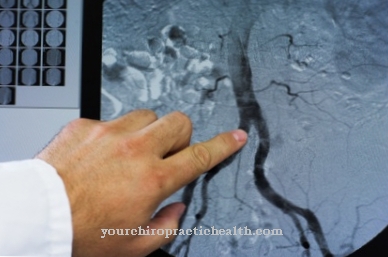Imaging procedure is a generic term for various diagnostic methods in medicine. Frequently used imaging procedures are the X-ray procedure and the ultrasound diagnosis.
What is an imaging procedure?

In almost all medical disciplines, various apparatus-based imaging processes are used to depict organs and tissue structures in the patient. The resulting two- or three-dimensional images provide important information for diagnosing diseases. Diagnostic imaging methods have therefore become an indispensable part of today's medicine.
Function, effect & goals
X-rays, a high-energy electromagnetic radiation, was discovered by Wilhelm Conrad Röntgen as early as 1895 and has since been used in the diagnosis of diseases. Today, radiology plays an important role in accident medicine and in the diagnosis of lung diseases. A so-called X-ray tube is used as the radiation source for X-rays. The radiation leaves the X-ray apparatus and hits the X-ray film or, in more modern radiography, an X-ray storage film or electronic sensors. This is where the actual X-ray image is created.
The patient stands between the X-ray machine and the X-ray film. The X-rays hit the patient's body and are absorbed there to different degrees, depending on the nature of the respective tissue. The part of the radiation that has penetrated the body and has not been absorbed hits the X-ray film. Due to the different absorption and thus the shadows and lightening appearing on the X-ray film, images of the body structures are made possible. Radiopaque tissues, such as bones, only allow a small amount of radiation to pass through. The X-ray film is only slightly blackened and the bones appear light in the X-ray image. Often, the patients are given a contrast medium before the X-ray. In this way, structures can also be made visible that are otherwise difficult to delimit.
Computer tomography is a modern X-ray method. During this imaging procedure, the body is X-rayed in layers. A computer then creates a cross-sectional image of the body. Contrast media are also used here in order to obtain a more meaningful image. An important area of application for computed tomography is neurological diagnostics. CT is used if a tumor, traumatic brain injury or stroke is suspected. Computed tomography is also used to search for metastases in the case of known cancer.
Another imaging method is magnetic resonance imaging, also known as nuclear spin or MRI for short. The MRT also enables a layered representation, but does not use ionizing radiation, but is based on the principle of nuclear magnetic resonance. Magnetic resonance tomography is based on the spin of atomic nuclei with an odd number of protons or neutrons. These atomic nuclei rotate independently and thus have what is known as spin. This physical property makes them magnetic. In the normal state, these spins are disordered. However, if a strong magnetic field is used in the MRI, all atomic nuclei align themselves in parallel. The alignment of the atomic nuclei is disturbed by short high-frequency pulses.
When returning to their original state, the atomic nuclei emit electromagnetic waves that are registered by special sensors. From these electromagnetic waves, the computer then creates an evaluable image that shows the body structures in layers. The MRI is mainly used to diagnose CNS diseases. Ultrasound diagnostics, also known as sonography, is based on the fact that ultrasound is partly absorbed and partly reflected by human tissue. The ultrasonic waves are generated by a transducer and sent at short intervals or as continuous sound. To avoid disruptive air bridges, a gel is used, which serves as a transmission medium. The sound waves that are reflected by the tissues are picked up as echoes by the transducer. An image is generated by further electronic processing within the ultrasound device.
Sonography is used as a diagnostic tool primarily for thyroid diseases, abdominal complaints and to clarify diseases that affect the heart. The prenatal care is also done with the help of ultrasound. No rays are produced during ultrasound treatment. In addition, the examination is painless. A variation of sonography is the Doppler method. Here the ultrasound head constantly sends out waves. If they hit moving surfaces, e.g. The waves are reflected on the cell wall of a blood cell. When the transmitted and reflected waves meet, a sound is created. This is made audible through amplification. The Doppler procedure is used, for example, during pregnancy. The procedure is used to monitor the child's heartbeat. Doppler ultrasound is also used in vascular medicine to test flow conditions in arteries or veins.
Risks, side effects & dangers
The X-ray procedure is the most harmful imaging procedure for the body. The radiation doses in radiology are quite low, but repeated x-rays can lead to damage within a shorter period of time. Around one and a half percent of annual cancer cases are said to be due to radiation exposure from X-ray diagnostics. A study by the specialist magazine "Cancer" reported that the risk of developing a brain tumor increases significantly with regular X-ray examinations at the dentist.
In children, the risk of a brain tumor increased by a factor of five as a result of dental x-ray diagnostics. Scientists agree that x-rays, including computed tomography, should be kept to a bare minimum. The X-ray passport was introduced in Germany for this purpose. All x-ray examinations of the patient are entered here in order to avoid senseless and duplicate examinations. X-rays are absolutely contraindicated in pregnant women, as they can harm the unborn child. Magnetic resonance tomography and ultrasound manage without radiation and are therefore considered to be well tolerated.




.jpg)






















